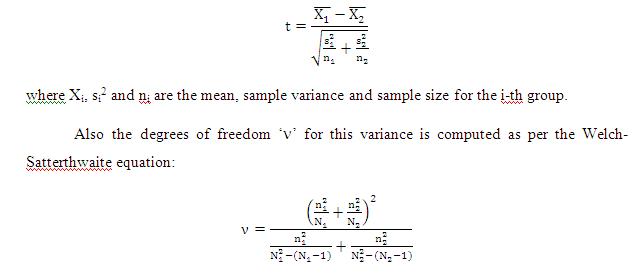- Business Concepts ›
- Statistics ›
- Welch-Satterthwaite T-Test
Welch-Satterthwaite T-Test
Definition & Meaning
This article covers meaning & overview of Welch-Satterthwaite T-Test from statistical perspective.
What is meant by Welch-Satterthwaite T-Test?
In case where one has to compare two non-paired groups with unequal variances, the standard t-test which assumes equality if variances of the two groups, cannot be used. The test then used is called the Welch-Satterthwaite t-test.
Method:
The null hypothesis in case of two groups with unequal variances is that the two variances are different. Such a situation may arise while comparing two production processes for comparing line performance. This assumption has to be affirmed or negated through the test.
In the normal Student’s t-test, in case of two groups, as the variances are assumed to be pooled and equal, the t-statistic (parameter to be tested for a hypothesis) is simply the difference in two means divided by the single standard error (variance divided by sample size). But in this case, as the variances differ by the problem definition, the t-statistic is computed differently as:

Then the standard procedure is followed by comparing the t-statistic with the t-distribution table. If the value of the t-statistic lies outside as specified by the confidence interval in question, then the null hypothesis is rejected, otherwise it cannot be rejected.
This article has been researched & authored by the Business Concepts Team which comprises of MBA students, management professionals, and industry experts. It has been reviewed & published by the MBA Skool Team. The content on MBA Skool has been created for educational & academic purpose only.
Browse the definition and meaning of more similar terms. The Management Dictionary covers over 1800 business concepts from 5 categories.
Continue Reading:
What is MBA Skool?About Us
MBA Skool is a Knowledge Resource for Management Students, Aspirants & Professionals.
Business Courses
Quizzes & Skills
Quizzes test your expertise in business and Skill tests evaluate your management traits
Related Content
All Business Sections
Write for Us